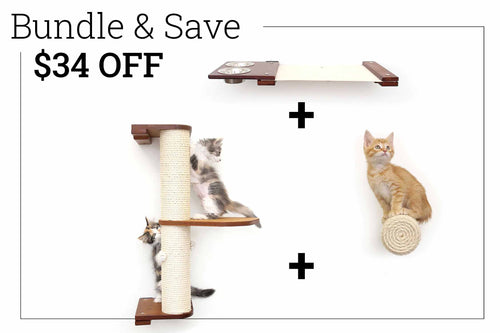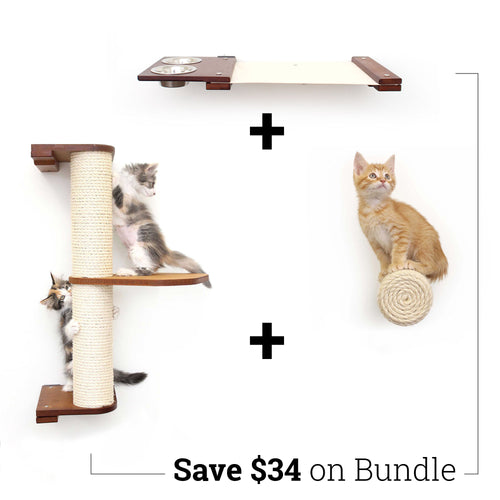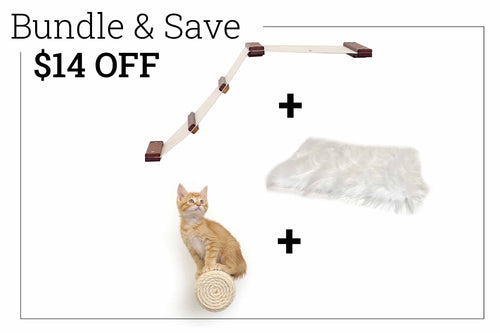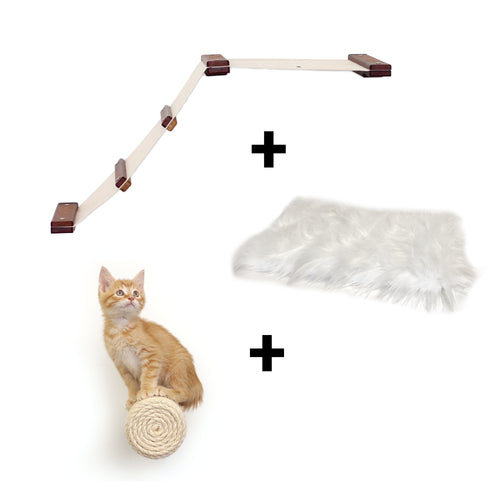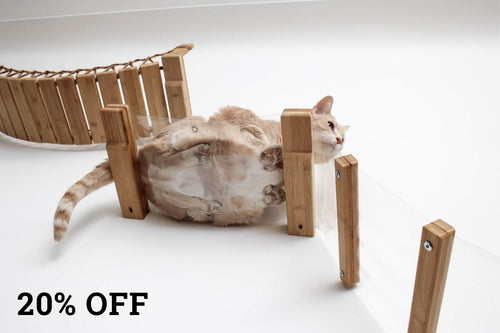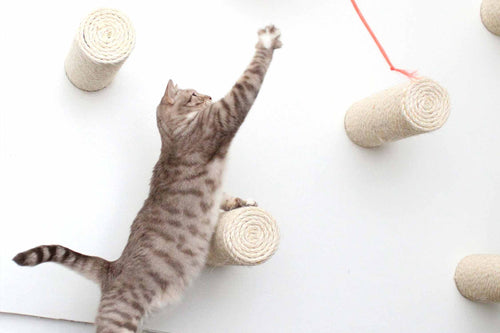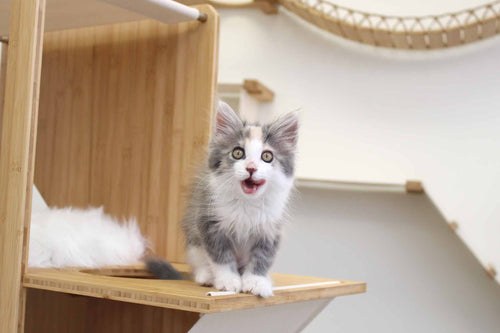How to Fix Cat Behavior Problems – 9 Cat Behavior Issues & Fixes
Cats bring with them a unique set of behaviors to any household. While most behavior issues will be an expression of your cat’s natural instincts, always start with ruling out medical problems with your vet. Some behaviors—like aggression, over-grooming, inappropriate elimination, etc.—can have roots in a medical issue. Once your cat has been deemed healthy by your vet, you can look into training as a treatment for behavior issues. While feline behaviors can be complex, the aim of this article is to provide a short list of common behavior issues, along with a few common solutions. The gold standard for addressing behavior concerns is speaking with a veterinary behaviorist or certified cat behavior consultant, both who will be trained to look into your cat’s unique behavior issue. Some common behavior issues are listed below. Along with the recommended positive treatment options for your cat.
Kitten biting
Rough play and play biting is a normal developmental behavior in cats. At these early ages the kitten learns how and what to play with, developing lifelong habits as well as honing in on mini cat physical abilities. This can become a problem when they get carried away and leave you with scratches and little tooth scrapes. To help set your kitten up to learn healthy habits, or help an older cat reduce rough play, here are some options.
Provide your kitten or cat with lots of enrichment toys, perches, scratching poles, outdoor enclosures, leash walks, training sessions, food puzzles, as well as easy things like paper bags and boxes to explore. What you practice you get better at and the same goes for cats. Help them practice a healthy variety of behaviors with lots of feline stimulation.
Give structured play time play a few times a day. Keep play fun but not totally out of control and funnel your cats instinct to the toys, cat lures, crinkly toys, catnip filled balls, etc. Try to keep the toys fun, interesting and new or different each day.
Refrain from using your hands to play as tempting as that might be. Remember kittens will grow up and even at that young age the behaviors they learn will turn into adult versions later. If you want to play with hands, calmly redirect that behavior to a toy.
Being bit and scratched can trigger us to instantly become more rough or defensive, but try to calmly end play if you do get scratched or bitten. Punishment or continued rough play will intensify the behavior issue, either by increasing the frenzy or actually scaring your cat away from healthy play later.
Add a calm training activity to your cats day, like clicker training
Cat scratching furniture
Scratching is a natural behavior for cats, used to mark their territory, stretch, and nail care. If your cat is scratching objects that you prefer it wouldn’t, you can redirect the behavior by providing scratching posts and other toys your cat can dig its claws into.
Use a trained recall to call your cat to you and redirect them to an appropriate activity.
Place a cat tree or scratching post at the location your cat is scratching to act as the new scratch location. Consider surface and material preferences, as each cat may be drawn to different things like wood, cardboard, rope, or fabric.
Use catnip on the posts to entice your cat to use them.
If the issue is urgent, many vets recommend painless and safe nail caps. These are small colorful plastic sleeves that fit over the claw.
Provide multiple scratching locations in the house. If the behavior is satisfied on desired locations, the older inappropriate scratch location loses value to the cat.
Excessive cleaning
Compulsive licking in cats typically stems from pain or stress. While all cats lick to groom themselves, excessive licking may be serious and result in hair loss and skin problems.
Rule out medical causes for any obsessive behavior; licking to the point hair is missing or there is a skin issue will require a veterinarian.
Reduce stress in home, looking for possible stressors like another cat, a new puppy, small space, or lack of enrichment.
Consider with your vet if adding a feline pheromone diffuser is appropriate.
Add hiding and climbing options for your cat to have safe and de stressing down time.
Recall using only positive reinforcement from a licking episode
Help find ways to redirect behavior to a food enrichment puzzle to a training game to help manage.
Nighttime activity
Cats express the roots of their wild relatives when they are more active at night. They can be very vocal and loud, which can be disruptive to someone sleeping. Nocturnal animals can successfully switch their sleeping schedule to match eating and household activity and synchronize sleeping times and here are some ways that may help.
First, make sure your cat has no medical problems. An overactive or fussy cat could be in pain or discomfort and you always want to rule out any medical issues before looking into training and management.
Sleep is needed after mental and also physical exertion.
Environmental enrichment, like climbing areas, tunnels, training a new behavior, interactive food toys, and new toys can help tire them out throughout the day.
Use play in short sessions to keep your cat active, play in new locations and in different ways, with different toys to keep the play ever changing and your cat learning. Even everyday objects like boxes, bags, and packing paper can serve as some of the best toys.
Cat taking another cat's food
This is when cats become interested in another cat’s food and try to eat that cat’s food during mealtime. This can result in stress and conflict as cats fight over resources. Here are some ways to help prevent these food related problems.
With a multi cat household, find ways to promote the behavior you want by rearranging the environment. To create safe feeding areas for each cat use a baby gate, door or furniture to prevent the undesired food hogging behavior. These physical boundaries will start each cat practicing the desired behavior and create a habit.
Consider using food puzzles to engage the cats more in their own meals.
Train both cats to eat and stay in one location.
Another option is to give the fast eating cat an enrichment toy with food after they finish early and give it to them in another safe location away from meal time.
Once good habits are created and your cats are finishing up, watch to see what is still needed to distract or keep the peace between them.
Jumping on counters
Cats love to climb and they jump onto counters for many reasons. Here are some common reason and way to help in this situation:
When they jump for food, start by removing all food from the counter and train your cat to go to a location while you get meals ready.
When it seems that they want to get higher, create an alternative route leading to where they want to go using wall shelves or other furniture. If it seems like they want to rest up on the counter, make a better lounging space a little higher and near that location to redirect that cat behavioral need to perch up high. A cat heating pad, hammock, or bed can act as great solutions.
If they're jumping up to gaze out the window, use window film or allow window gazing at another location by adding a cat shelf or hammock away from the counters.
Chewing issues
Chewing behavior in your cat may be caused by a medical issue, boredom, stress, teething in kittens, or disruptions in development in early weaned kittens. After getting the clean bill of health from you vet you can get started.
If you have a cat chewing to manage stress of anxiety, have a look at the environment. Has anything changed?
A new dog or cat may need a careful introduction plan.
Desensitize slowly to new changes in household.
If your cat is bored, increase enrichment.
Provide chewy chewing alternative toys that are cat safe.
Manage your cats environment to make it safe.
Cover small and dangerous items, like electrical cords, with plastic housing.
Close doors to office rooms or add high baby gates can help.
Excessively vocal
Your cat may show more vocal behavior when it would like food, to go outside, or to get your attention. Some breeds are also known to be more vocal cats, however cats are individuals and any cat can become vocal. There may be multiple causes, if this behavior is not typical.
Howling can be a sign of senility in older cats.
Try increasing enrichment to help give a board array of healthy cat activities.
Cats that are crying while eliminating in the litter box can have a painful medical problem, so please check with your vet if you suspect this.
If your cat is vocalizing for treats they may have learned that is how they get food. The vocalization is easy to reinforce with attention or food, instead, reinforcing any non vocal behavior like sitting or a period of silence. This gives you less vocalizing around food and gives your cat another more acceptable way to express their enthusiasm.
Some cats can also have separation related vocalizations, such as when you leave for work or to get groceries. Working with a feline behavior consultant or veterinary behaviorist can help address these behavior issues.
Begging for food
Cats, of course, don’t seem to notice any sort of distinction between food for us and food for them and might beg, smack, meow, or even become aggressive to get to the food while you cook or eat. Here are a few ideas to help:
For mild cases, simply feeding them in a puzzle feeder just before you sit to eat can allow them to practice a new behavior that pays much better than begging while you eat.
Never feed your cat just a little treat of your food while you are eating, if begging bothers you.
Some people will be fine sharing food, but remember, a cat doesn't know the difference between you and a stranger when it comes to food sharing time. Expect your cat to be persistent, if begging works sometimes, but not always.
For more insistent cats who might not be interested in dry treats in a puzzle feeder, consider a food hunt using small caps or bowls and using wet cat food, tuna, boiled chicken. This will be much more enticing for you cat, allow your cat a healthy outlet for boredom while also addressing your issue of begging for food.
Train your cat to go to a location for treats, then only give you cat treats in that location.
These are just a few common behavior issues cats present you with, if you are having a serious issue with your cat a veterinary behaviorist has help. To find a vet behaviorist near you at the The American College of Veterinary Behaviorists
Read More »

